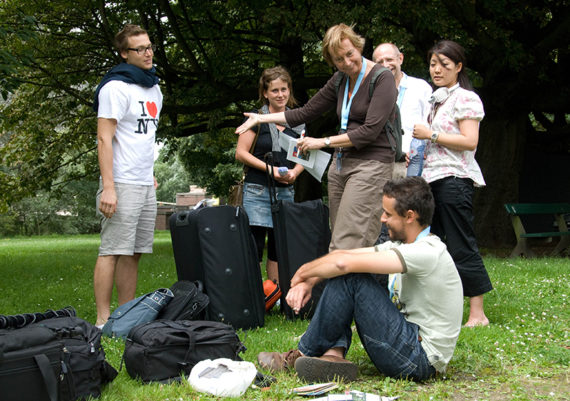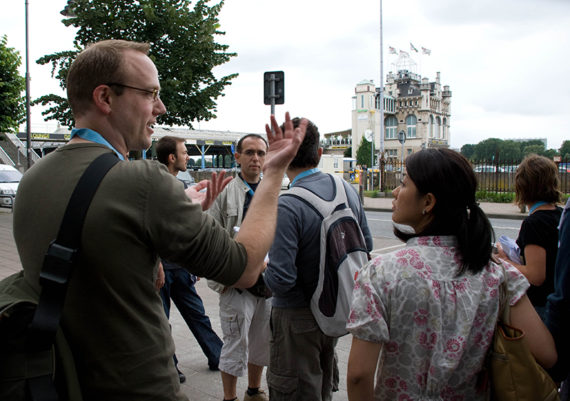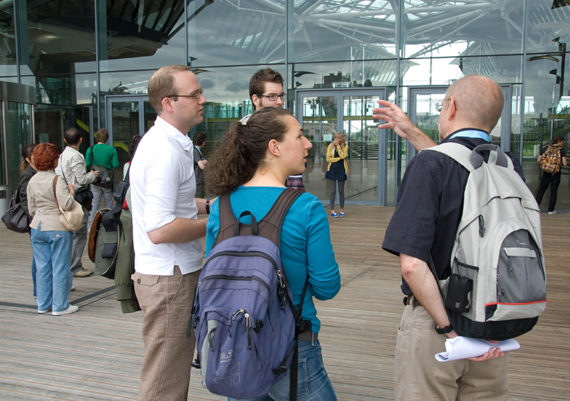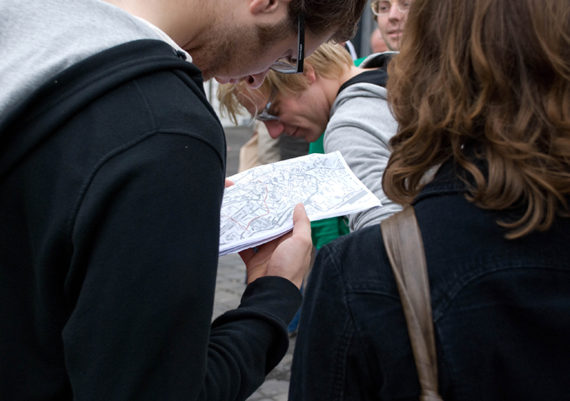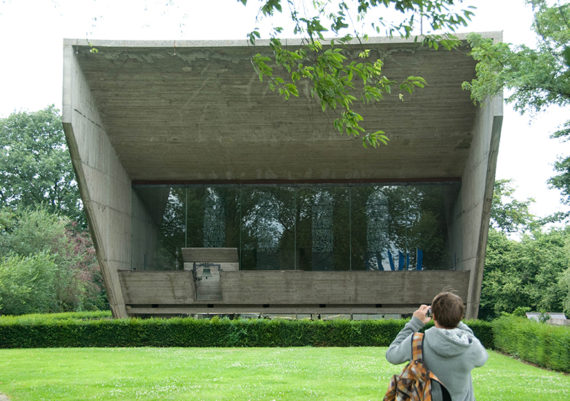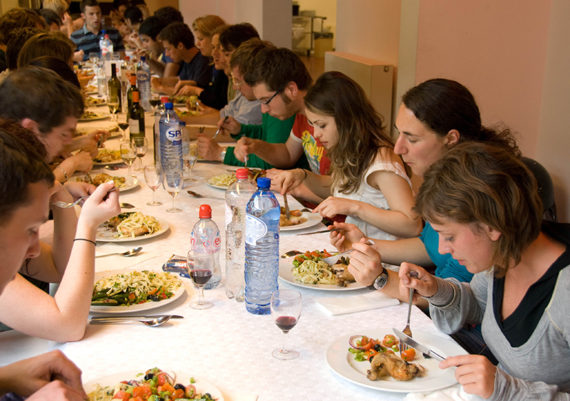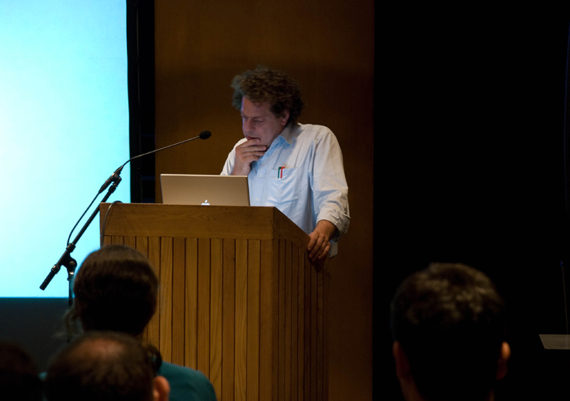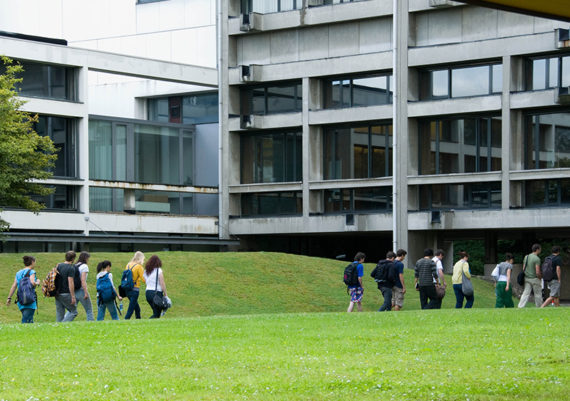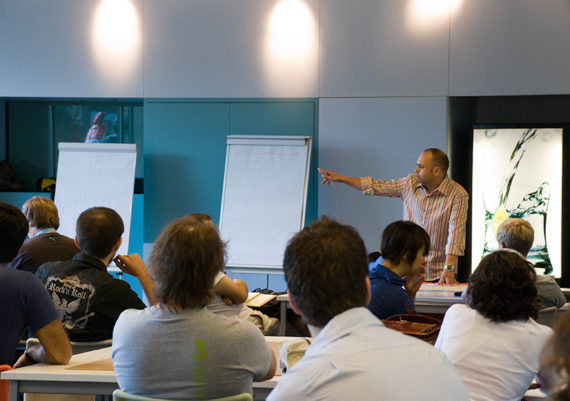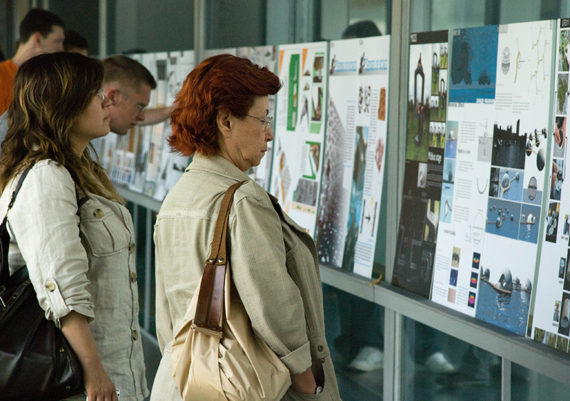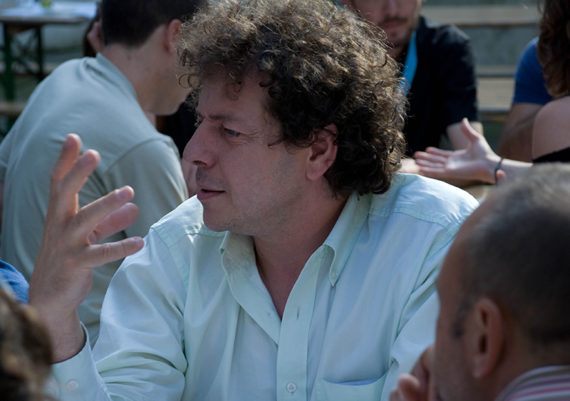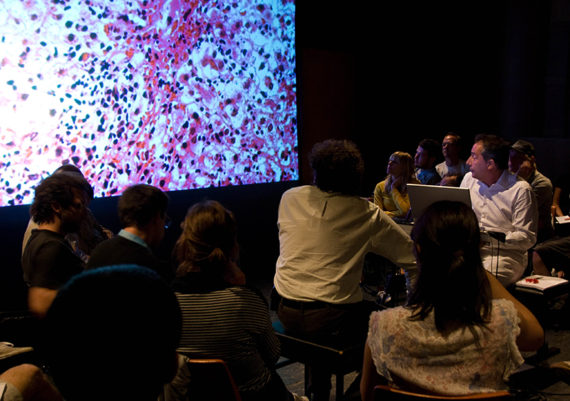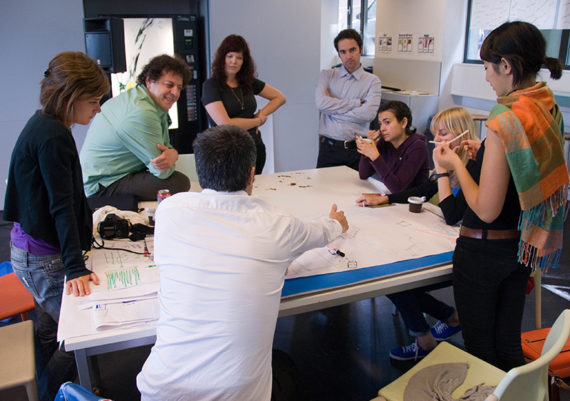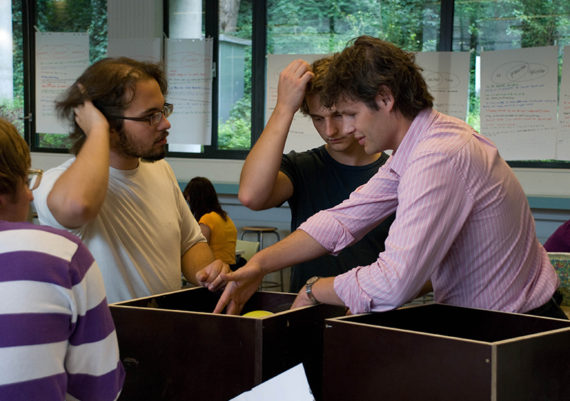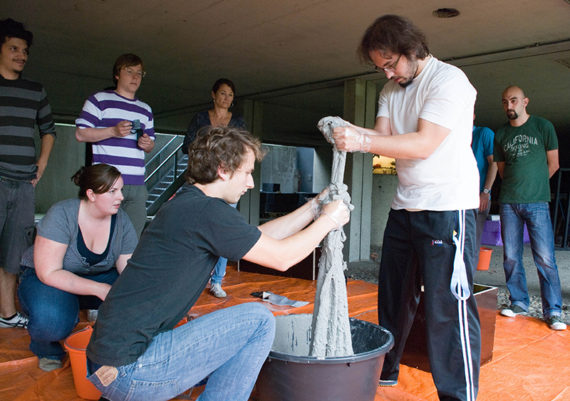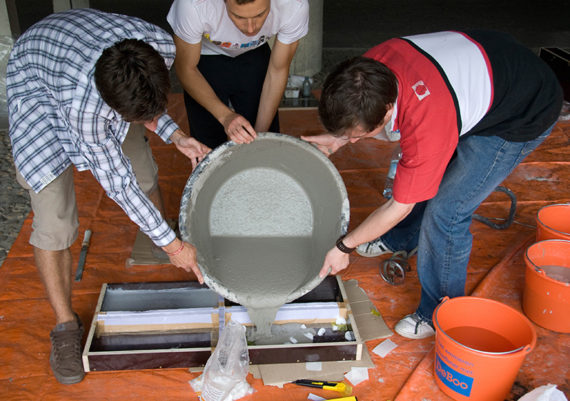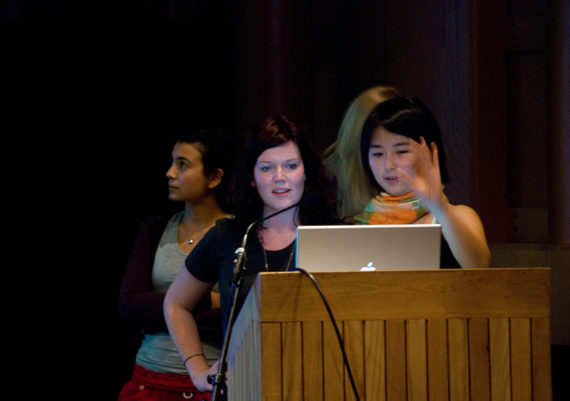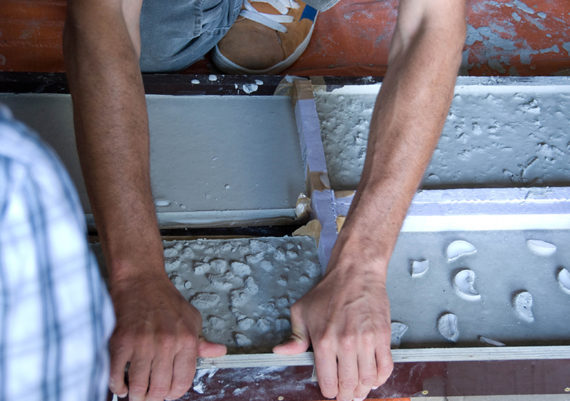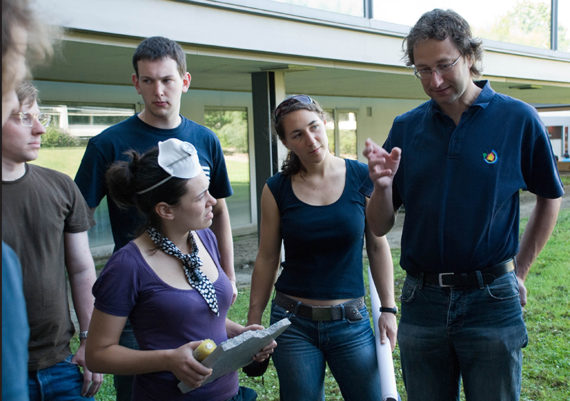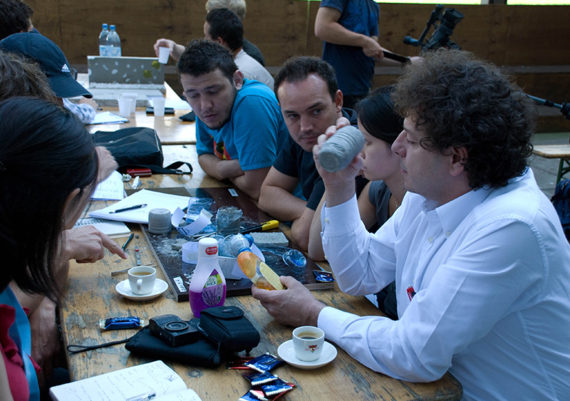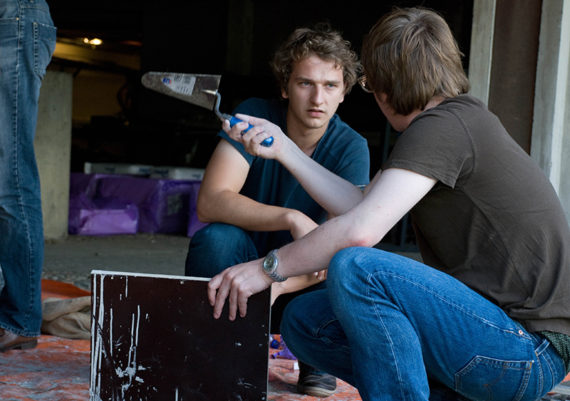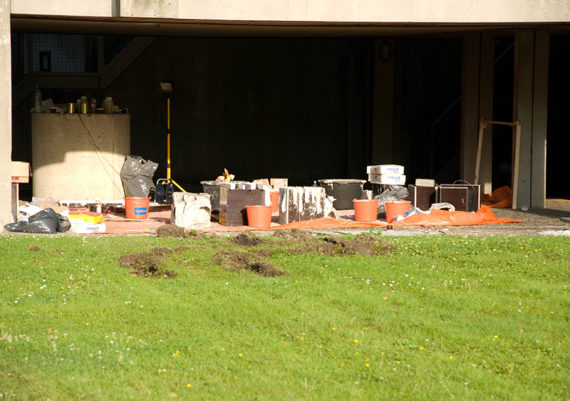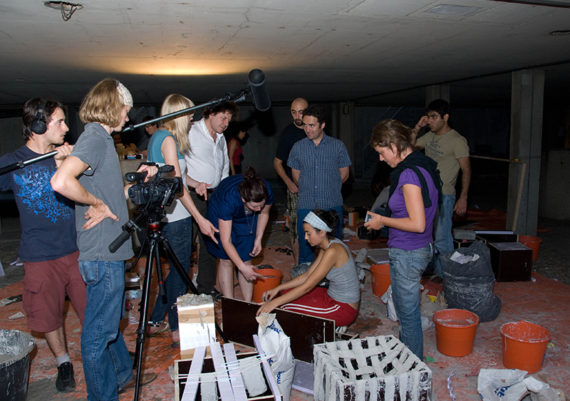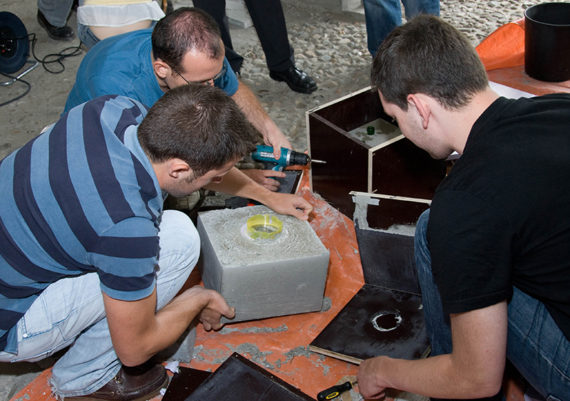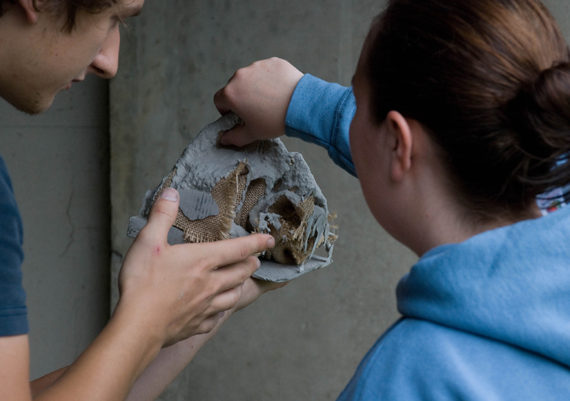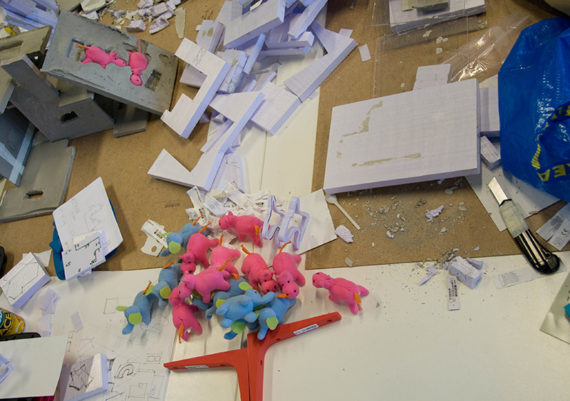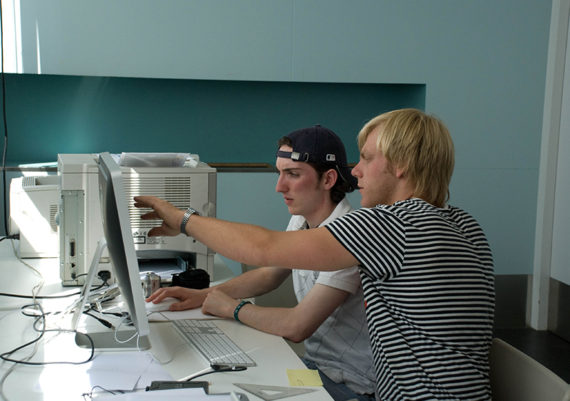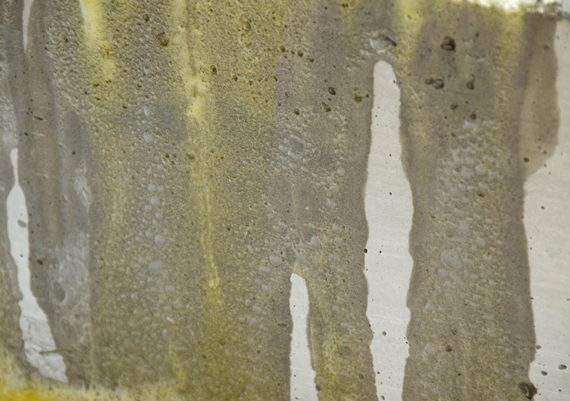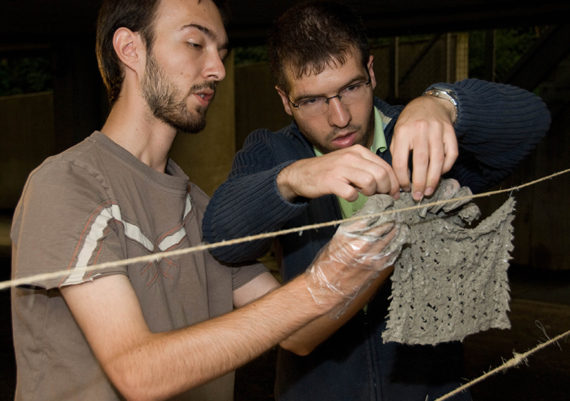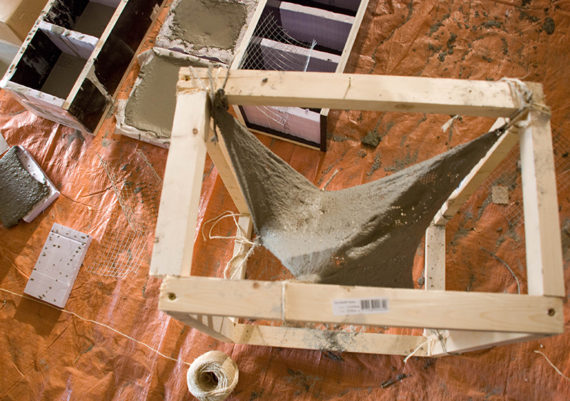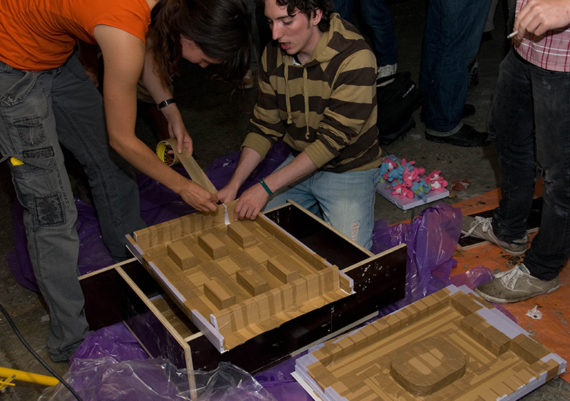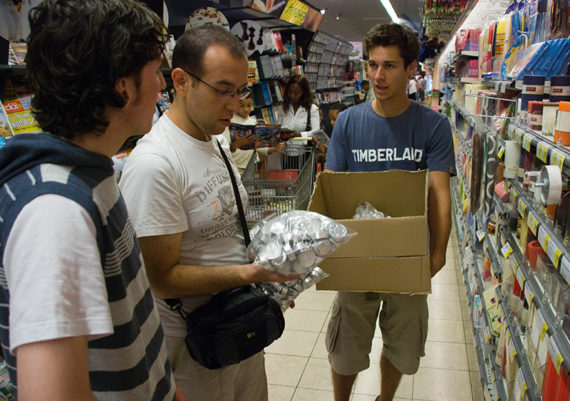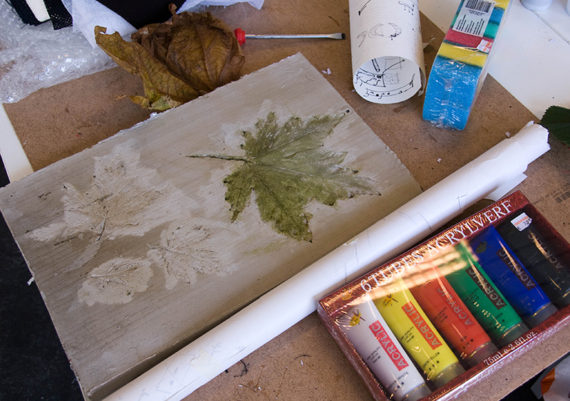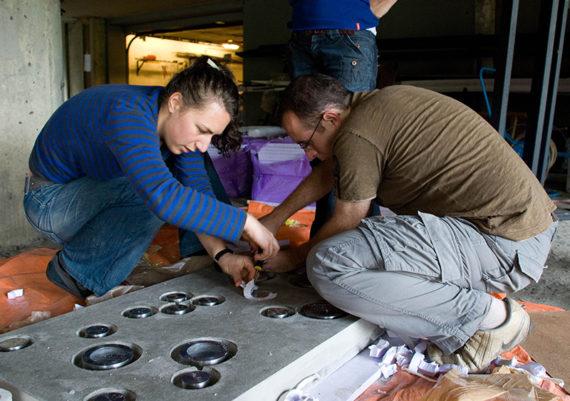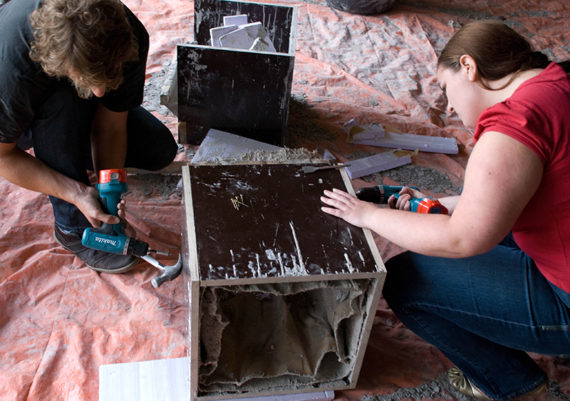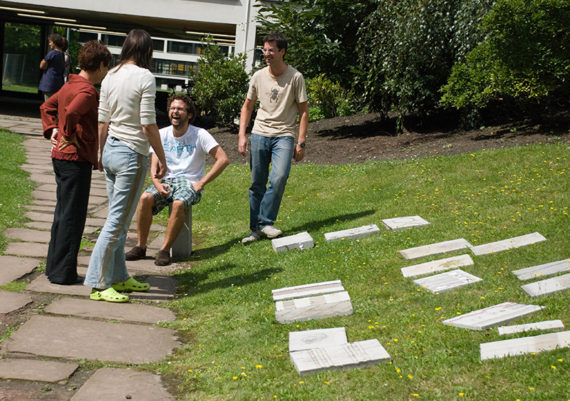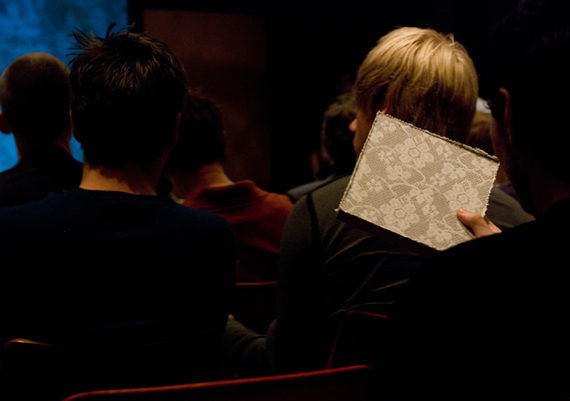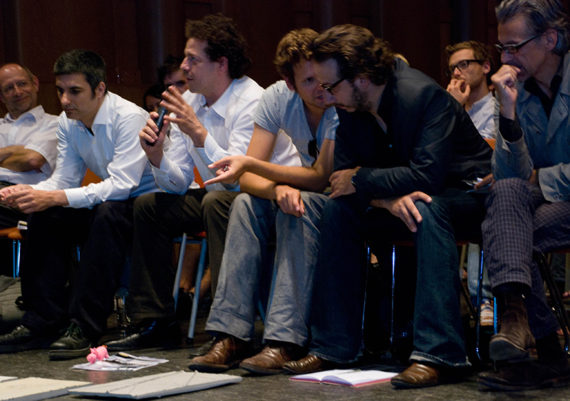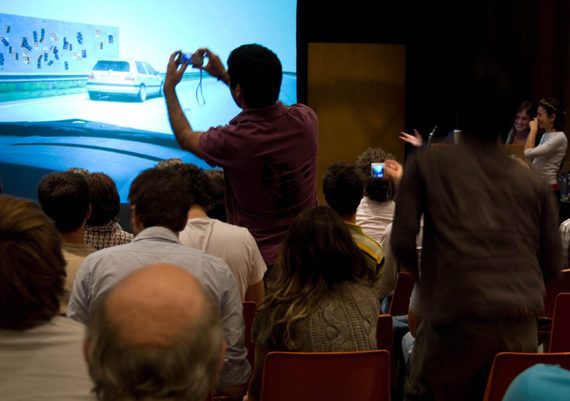Concrete Design Competition & Master Class on Implicit Performance
Juan Herreros set the theme for the third Concrete Design Competition as 'Implicit Performance'. Students had to investigate the hidden properties and characteristics of concrete as a monolithic material as well as in hybrid structures. A quest for new performances and materials that led to a variety of extreme examples of techniques, materials and products.
2007 - 2008
concept, coordination & management, tutoring, publication
Implicit Performance
Documenting the Concrete Design Master Class on Implicit Performance led by curator Juan Herreros. Antwerp, August 2008.
film
Aaron Hauptman, Wies van Saus
editing
Siebe Bakker
English
Implicit Performance, exploring the hybrid condition
Webster’s Third New International Dictionary:
Im-plic-it adj [L implicitus, past part. Of implicare to infold, involve, implicate, engage – more at EMPLOY] 1 obs: tangled or twisted together : INTERWOVEN 2a (1) : tacitly involved in something else : capable of being understood from something else though unexpressed: capable of being inferred : IMPLIED – compare EXPLICIT (2) : involved in the nature or essence of something though not revealed, expressed, or developed : POTENTIAL b (1) : not appearing overtly : confined in the organism (2) of a culture : capable of being derived only as an implication from behavior : not apparent or overt to the people it characterizes : tacit and underlying 3a : lacking doubt or reserve : UNQUESTIONING, WHOLEHEARTED b obs: UNQUALIFIED, ABSOLUTE 4 archaic : marked by an implicit faith, credulity, or obedience
Hybrid 1a : marked by heterogeneity in origin, composition, or appearance : Composite b : being a linguistic hybrid 2 : of, relating to, or resulting from the union of gametes from parents of different genotype. 3 : having characteristics resulting from two diverse cultures or traditions.
Reinforced concrete has always played an autonomous role in architecture. The division of the construction process into Skin, Skeleton, Installations and Interior organization was a major breakthrough in its day. It triggered an expansion of concrete’s applications within architectural design that has reached practically all areas of building practice. But concrete has always been concrete and, where concrete ended, something else always began. Let us say that concrete has been an individually identifiable material, always protagonist of the systems in which it participates, most of the times even as the only player. However times are changing and the transparency created by the clear identification of constructive elements and materials is nowadays disappearing thus constituting a blurred state in which the old dream of the desirable compatibility between discriminate components has created a new condition; merging components into one another, thus making it impossible to distinguish the boundaries between them. Concrete is a specific material with its own science and culture, and only very recently has research been started into the possibilities of being integrated in more complex systems other than its own forms of technologies and applications. To open this exploration to schools and create an experimental platform for future applications of concrete as an integrated constructive resource is the main objective of this competition cycle.
ooking into other areas of technical evolution, it appears that there is a common interest in dissolving the limits of what had been thought of, designed as, and used for perfectly differentiated applications. This trend in construction materials and resources, what we call “crossbreeds” or more precisely “hybrids”, combines different ingredients. Some of these ingredients have yet to be included in construction systems in order to create new products with properties and applications that differ from applying the same items in an individual yet collaborative way. This is however not merely a material or structural concern. There is a deeper interest within this research generated by calling upon the integration of different fields of knowledge, methods of design, and functions. The “hybrids” of interest are those that offer complete systems. The root of this statement indicates a future for numerous extraordinary possibilities in a new construction culture. “Hybrids” play an exciting role because apart from being structural, constructive or efficient, they should also be spatial, aesthetic and open enough to be adaptable to different situations. Thus creating conditions in which no apparent limits are found for using a wide and innovative range of elements. Including live or “animated” ingredients combined with recycled products or those that previously were rejected by design practices and construction science.
This integrating condition, which we prefer to call ‘Implicit Performance’, is offered through the above-mentioned possible systems and should nowadays also include concrete. This is the objective of the competition: to explore and exploit the limits of the involvement of concrete with other resources to create new construction materials and applications where concrete forms the basis but is not the only element at play. It is therefore a question of finding conditions of compatibility and integration –we could say a “complicity”– between concrete and something else in order to create a new material or system that adopts other characteristics. We look for concrete surpassing its “original” performance to the point of becoming a new material in and of its self with contemporary spatial and experiential consequences. Behind the collective work that the competition evokes, there is an interest of generating practical implementations of theoretical topics on architecture as the construction of a second nature or second life. Creating architectural applications and systems for a world that needs to seriously reconsider the material conditions with which construction and demolition takes places.
Juan Herreros
Madrid, 2007
Concrete Design Master Class on Implicit Performance
The Concrete Design master Class on Implicit Perfomance took place at deSingel in Antwerp, Belgium. From August 2 till August 9, 39 students from the 8 participating countries continued their investigation in the competion's theme under guidance of curator Juan Herreros. The students, all laureates of the competition, worked in groups that each produced series of prototypes. They explored the possibilities of the material in relation to their interpretations of the theme. The investigations ranged from deteriorating surfaces to actively sensuous samples and were focused on structural properties, production techniques and esthetical appearances. The combined body of work and research produced during the master class represented an intriguing and challenging outline of future architectural applications in concrete.
The week started relaxed by exploring the city of Antwerp and its surroundings but quickly turned into a true workshop atmosphere. The first lecture of the week by Juan Herreros introduced the participants to the ambitions of the master class, to be scientific. By this Herreros meant 'to be of use to others', to produce a research that is valuable to users, industry and designers. The participants almost immediately had to generate concrete objects reflecting their view on 'Implicit Performance'. The objective of the master class was to produce a large quantity of comparable physical objects, iterations on a focused segment of investigation. Rather than working towards one conclusive 'final object', the ambition was to lay out a field of plausible applications. In doing so the various limits of the material and the ways in which concrete architectural objects can be produced were discovered and challenged. It is exactly this matrix of trials and errors that produces an acute awareness of the material's potential and of the position of applied material research within a design process. In other words to explore the width of possibilities rather than to focus on the one solution. Or in Juan Herreros' words to actively submerge into a state of 'suspended reality' that will only reveal its true impact later on in ones endeavors.
The master class program was supported by a range of experts facilitating various needs and included keynote lectures by Enric Ruiz-Geli and Kersten Geers. Architects and critics from Spain - Angel Borrego and Jacobo Garcia German - and Belgium - Guy Chat�l and Stefan Devoldere - appeared during the week. Expert material and engineering support was offered by Arjan Habraken, Luc Tearwe and Peter Lieblang. While the general workshop process was guided by Ifke Brunings, Patricia Hessing and Siebe Bakker with FEBELCEM's Jef Apers as international coordinator, host and concrete expert as well.
The above-mentioned people represent just a portion of the energy and resources that was given. We like to thank all persons and organizations that have contributed to this master class. A special mention is reserved for Moritz Kung, curator of deSingel and his team for enthusiastically embracing our project and for their flexible support throughout the week.
We feel honored to have worked with Juan Herreros who's energetic and inspiring presence hovered over the works in progress truly unveiling concrete's implicit performances. Without the tremendous efforts of the individual participants during the competition and the master class none of this could have been achieved. Thank you all so much!
Roisin Aherne, Fatma Aliosmanm, Marcos Belmar, Paolo Borghino, Ayse Bozkurt, Diego Cayuelas Garcia, Stefano Cerolini, Yü Chen Jamie Doak, Wouter Dreessen, Zeynep Erdinç, Ahmet Irfan Ertis, Åse Flindall, Barbara Grassl, Juliane Greb, Ryoko Ikeda, Alper Kanyilmaz, Emre Can Korkmaz, Benedikt Krienen, Radim Louda, Karmen de Maaré, Rikje Maas, José Maria Martinez, Eleonora Massaccesi, Hans Ooms, Ege Özgirin, Kadir Öztürk, Daniel Patterson, Lucy Riordan, Gertjan Rohaan, Halidun Senkal, Sasha Smolin, Fredrik Sund, Eduardo Tajuelo del Rosai, Gereon Töpper, Tolga Tutar, Santiago Varela Rizo, Thuy Vu, Felix Wurst
curator
Juan Herreros
tutors
Siebe Bakker, Angel Borrego, Ifke Brunings, Jacobo Garcia German, Patricia Hessing, Jasper Westebring
critics & experts
Guy Châtel, Stefan Devoldere, Arjan Habraken, Luc Tearwe
lecturers
Kersten Geers, Enric Ruiz-Geli
support
Bart Braet, Leo Daems, Roland Dudal, Torsten Förster, Bernadette Scheerders, Koen Slock, Karla Stessel, Paul vermeir, Lisa De Visscher, Jan Wildiers
host
De Singel - Jerry Aerts, Moritz Küng
initiative
A.I.T.E.C. - Maria Teresa Briotti
BDZ - Torsten Förster
Cement&BetonCentrum - Hans Köhne
Cementa - Anita Stenler
Cement Manufacturers Ireland - Brendan Lynch
FEBELCEM - Jef Apers
IECA - Carlos Jofré
Norcem - Kristin Kvisvik
TCMA - Çaglan Becan
photography
Brigitt & Charlotte Albers
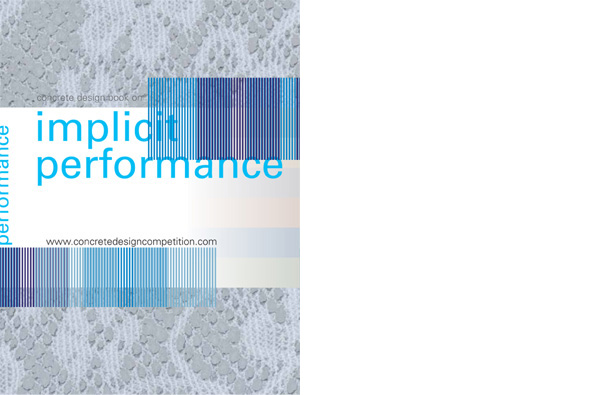
concrete design book on implicit performance
2008 / English
Documentation on Concrete Design Competition on Implicit Performance and Master Class for laureates, curated by Juan Herreros. Includes all nominated competition entries and photographic documentary of master class. Texts by Juan Herreors, Jef Apers and Siebe Bakker. Interviews with René Boomkens, Michael Braungart, Ben van Berkel, Klaus Bollinger, Manfred Grohman and Olafur Eliasson by Eric Frijters & Olv Klijn. Interview with Juan Herreros by Stefan Devoldere.
editor:
Siebe Bakker - bureaubakker
photography:
Brigitt & Charlotte Alberts
graphic design:
Manifesta
download pdf
backflap
'the objective of the competition: to explore and exploit the limits of the involvement of concrete with other recourses to create new construction materials and applications where concrete forms the basis but is not the only element at play. It is therefore a question of finding conditions of comparability and integration - we could say a "complicity" - between concrete and something else in order to create a new material or system that adopts other characteristics.
We look for concrete surpassing its "original" performance to the point of becoming a new material in and of its self with contemporary spatial and experiential consequences. Behind the collective work that the competition evokes, there is an interest of generating practical implementations of theoretical topics on architecture as the construction of a second nature or second life. Creating architectural applications and systems for a world that needs to seriously reconsider the material conditions with which construction and demolition takes place.
Juan Herreros, curator
